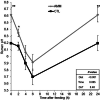A novel ammoniation treatment of barley as a strategy to optimize rumen pH, feed degradability and microbial protein synthesis in sheep
- PMID: 33709464
- PMCID: PMC8451892
- DOI: 10.1002/jsfa.11205
A novel ammoniation treatment of barley as a strategy to optimize rumen pH, feed degradability and microbial protein synthesis in sheep
Abstract
Background: Meeting the energy and nitrogen (N) requirements of high-performing ruminants at the same time as avoiding digestive disturbances (i.e. rumen acidosis) is a key priority in ruminant nutrition. The present study evaluated the effect of a cereal ammoniation treatment, in which barley grains are combined with urea and enzymes that catalyze the conversion of urea to ammonia to optimize rumen function. Twelve rumen cannulated sheep were randomly divided into two groups and fed a diet containing 60% of ammoniated barley (AMM) or untreated barley supplemented with urea (CTL) to investigate the impact on rumen fermentation and feed utilization.
Results: AMM had higher total N content and effective rumen degradable N than untreated barely. AMM sheep had a consistently higher rumen pH throughout the day (6.31 versus 6.03) and tended to have a lower post-prandial ammonia peak and higher acetate molar proportion (+5.1%) than CTL sheep. The rumen environment in AMM sheep favored the colonization and utilization of agro-industrial by-products (i.e. orange pulp) by the rumen microbes leading to a higher feed degradability. AMM sheep also had higher total tract apparent N digestibility (+21.7%) and urinary excretion of purine derivatives (+34%), suggesting a higher N uptake and microbial protein synthesis than CTL sheep.
Conclusion: The inclusion of AMM in the diet of ruminants represents a valid strategy for maintaining rumen pH within a physiological range and improving N utilization by the rumen microbes, which could have positive effects on the health and productivity of animals in intensive production systems. These findings warrant further studies under conventional farm conditions. © 2021 The Authors. Journal of The Science of Food and Agriculture published by John Wiley & Sons Ltd on behalf of Society of Chemical Industry.
Keywords: ammoniation; barley; feed utilization; rumen fermentation; sheep; urea.
© 2021 The Authors. Journal of The Science of Food and Agriculture published by John Wiley & Sons Ltd on behalf of Society of Chemical Industry.
Conflict of interest statement
The authors declare that they have no conflicts of interest.
Figures




References
-
- Zebeli Q, Mansmann D, Steingass H and Ametaj B, Balancing diets for physically effective fibre and ruminally degradable starch: a key to lower the risk of sub‐acute rumen acidosis and improve productivity of dairy cattle. Livest Sci 127:1–10 (2010).
-
- Zebeli Q and Ametaj B, Relationships between rumen lipopolysaccharide and mediators of inflammatory response with milk fat production and efficiency in dairy cows. J Dairy Sci 92:3800–3809 (2009). - PubMed
-
- Pardo G, Martin‐Garcia I, Arco A, Yañez‐Ruiz DR, Moral R and Del Prado A, Greenhouse‐gas mitigation potential of agro‐industrial by‐products in the diet of dairy goats in Spain: a life‐cycle perspective. Anim Prod Sci 56:646–654 (2016).
-
- Arco‐Pérez A, Ramos‐Morales E, Yáñez‐Ruiz D, Abecia L and Martín‐García A, Nutritive evaluation and milk quality of including of tomato or olive by‐products silages with sunflower oil in the diet of dairy goats. Anim Feed Sci Technol 232:57–70 (2017).
-
- Salami SA, Luciano G, O'Grady MN, Biondi L, Newbold CJ, Kerry JPet al., Sustainability of feeding plant by‐products: a review of the implications for ruminant meat production. Anim Feed Sci Technol 251:37–55 (2019).
MeSH terms
Substances
Grants and funding
LinkOut - more resources
Full Text Sources
Other Literature Sources

